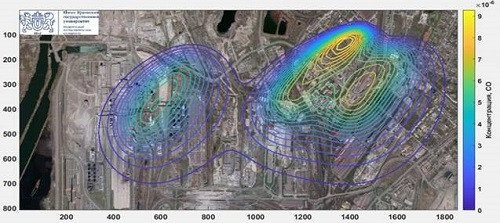Scientists of the South Ural State University (SUSU), Chelyabinsk, are working on the Ecomonitor system which would allow monitoring the spread of pollutants and reducing their concentration on the premises of industrial enterprises or in polluted cities. This innovative solution would enable modeling various pollution scenarios based on the weather forecast and offer appropriate and effective measures
The state of aerial environment is monitored using observation means and calculation methods. The problem of air pollution by systemic enterprises in cities is still relevant. Various air pollution measurement and forecasting methods are applied to solve it. For example, specialists rely on known methodologies to develop mathematical models of the distribution of pollutant admixtures in the atmosphere, but they try to modify them so as to identify zones with elevated concentration of pollutants and recommend reliable measures to lower the concentration.
For example, there is the improved air pollution control system proposed by the Russian specialists is aimed to produce prompt solutions to prevent increased concentration without an adverse impact on the environment. Under the Ecomonitor project, employees of the South Ural State University (Chelyabinsk) are developing mathematical models that could visualize the current situation in terms of pollution levels, analyze emission data and even predict the concentration of pollutants in the atmosphere.
Sergey Mikhailovich Elsakov – Candidate of Physico-Mathematical Sciences, Docent of the Department for Applied Mathematics and Computer Science as the South Ural State University spoke of the operation principle and the novelty of the proprietary product – the Ecomonitor system – and its potential capabilities.
The environmental monitoring project Ecomonitor was initiated in 2019 by the Rector of the South Ural State University, Professor Aleksandr Leonidovich Shestakov, Doctor of Engineering Sciences, and is led by Dmitry Aleksandrovich Drozin, Candidate of Economic Sciences.
A multidisciplinary team of SUSU employees was formed for the research, enabling application of the most advanced technologies to complete environmental monitoring tasks.
The scientists are planning on conducting field tests and comparing the results of models with those of the experiment, jointly with the project partners: Emerson LLC and Zavod TEKhNO LLC. In addition, a laboratory is to be launched jointly with Metran LLC to provide automated collection of measurement data in order to build high-precision models of the spread of pollutants in the atmosphere. The software system is to be delivered to the industrial client later this year.
Sergey Elsakov explained why such new air pollution control models were needed:
“Now, there is a great focus on environmental issues in Russia and overseas. In Russia, there is the ongoing national project Ecology, aimed to improve the state of the environment. Air quality management requires models that could predict concentration of pollutants in the atmosphere in a municipality or a company. The existing models fail to meet three requirements at once: high-precision modeling of the spread of pollutants; high-speed calculations; and adaptability to the local parameters of the emission source. The models that we develop meet the modern requirements.”
According to the scientist, the use of the Ecomonitor environmental monitoring system in regions would allow “identifying areas with elevated pollution levels promptly, identifying registered emission sources that affect those areas, and produce balanced solutions to reduce environmental risks for both the population and the enterprises.”
The main goal of the Ecomonitor project, as emphasized by Sergey Elsakov, is “to develop a system to model the spread of pollution in the atmosphere from multiple pollution sources, in real time, with the actual emissions from the sources taken into account. The modeling system enables prediction of the environmental situation, and management of environmental risks for enterprises as well as municipalities.”
General view of the Ecomonitor software system
What has been included in the Ecomonitor environmental monitoring system at this development stage?
“A software system has been developed that consists of several independent modules. The information collection and storage module allows accumulating information coming from weather stations, various sensors, and flowmeters. All information collected can be used by other components of the software system. The calculation module calculates the concentration of pollutants in the atmosphere in real time, based on all the information available. The visualization module allows viewing calculated air pollutant concentration maps. The reporting module forms electronic and paper reports on the state of the atmosphere in a given area and in control points for the relevant monitoring period. The forecasting module allows modeling various scenarios of pressure from emission sources, with the weather forecast taken into account. The model parameter identification module allows adjusting the model to a particular emission source on the basis of information collected, in order to increase modeling accuracy. There are also several modules that are still under development,” the Ural researcher clarified.
At present, specialists of the South Ural State University are working to create a mathematical model of the spread of air pollutants; they have presented the dispersion model SUSUPLUME.
“We are developing new air pollution spread models, which differ from the existing models in that, first of all, our models are designed to cover a great number of pollution sources. At enterprises or in populated settlements, emissions from thousands of sources often have to be taken into account, while each source is normally responsible for emission of dozens of different pollutants. Thus, taking pollution from all sources into account requires models that can be calculated within a reasonable time. The models built enable efficient use of computing resources to model the spread of pollution in the atmosphere for thousands of sources in real time.
Another distinct feature of the models we are working on is that they can be adjusted to a particular emission source and the surrounding development area. This provides more accurate real time modeling of the spread of pollution in the atmosphere from the source.
The SUSUPLUME model of the spread of pollutants in the atmosphere is based on the widely known Gaussian model of the spread of pollutant admixture in the atmosphere. This model class was chosen as the most adequate to the goal of the Ecomonitor project – real time calculation of the concentration of pollutants. Models of other classes have higher accuracy but the amount of computational resources they require is several times greater, which makes them unusable in real time. Within the Gaussian model class, the SUSUPLUME model is distinct in that it takes into account additional parameters that have a significant impact on pollutant concentration calculations: the molar mass of the pollutant, temperature, conditions of emission of pollutants from the pollution source. Moreover, the pollutant concentration calculation algorithm in SUSUPLUME works around 100 times faster than in other Gaussian models,” Sergey Elsakov went into detail on the algorithm and the fundamental difference of this proprietary mathematical model from the existing models.
Example of the concentration field of a pollutant, calculated for three sources.
How is the model adapted to real-life conditions? What are the results? (how numerical calculations compare to reality)?
“What should be taken into account when testing is that the SUSUPLUME model can be adapted to the local parameters of the emission source. A typical process of using the model looks like this. First, the monitoring system is deployed, which collects and models information from sensors installed. After a while, parameters of the model are adjusted on the basis of data collected. This allows the model to adapt to fluctuations in the workflow, to take into account the local parameters of the emission source.
The results of calculations made with the SUSUPLUME models were compared to real measurements, jointly with the project partners – the Chelyabinsk Region Office of the Federal Service for Supervision of Natural Resource Usage (RosPrirodNadzor). The results of the comparison turned out to be what is typical for Gaussian models. A comparison with real data on other sites is also in the plan with the project partners: Emerson LLC, a production company specializing in automated systems and instruments; and Zavod TEKhNo LLC, a thermal insulation plant. We hope that that the results of these comparisons will allow us to increase the accuracy of the SUSPLUME model,” the scientist remarked.
What is the next step? How are you going to develop this model or what models are you going to consider next for the implementation of the project of the Ecomonitor environmental risk management system?
“In the nearest future, we are planning to complete a model of the spread of pollutants in the atmosphere that takes into account land development and is based on the Navier–Stokes equations. Also in the final stage is a module calculating maximum one-time concentrations according to the МРР-2017 methodology, which would allow static assessment of pollution in an area as well as summary calculations across areas,” Sergey Elsakov outlined further tasks for the SUSU team.
Thus, the Ural scientists are developing the Ecomonitor system, which takes into account weather conditions and type of the substance polluting the atmosphere in the city – as a tool for making balanced decisions based on objective data.
All photos and pictures are provided by Sergey Elsakov
Photo on the page and on the main page: avtg/Photo bank ru.123.rf























